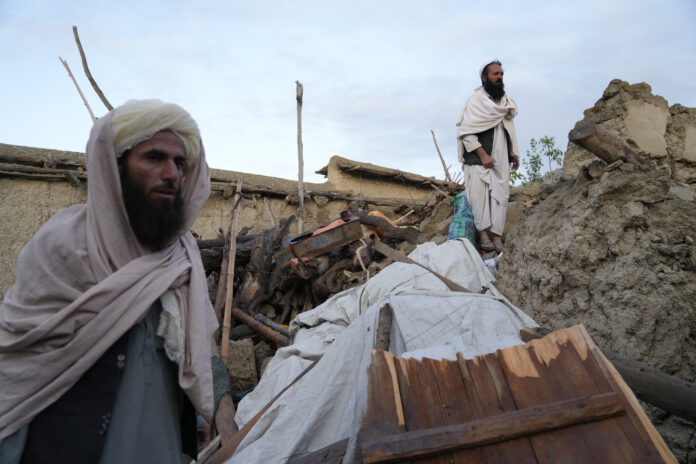Villagers rushed to bury the dead Thursday and dug by hand through the rubble of their homes in search of survivors of a powerful earthquake in eastern Afghanistan that killed at least 1,000 people. The Taliban and the international community that fled their takeover struggled to bring help to the disaster’s victims.
Under a leaden sky in Paktika province, which was the epicentre of Wednesday’s magnitude six earthquake, men dug a line of graves in one village, as they tried to lay the dead to rest quickly in line with Muslim tradition. In one courtyard, bodies lay wrapped in plastic to protect them from the rains that are hampering relief efforts for the living.
The quake was Afghanistan’s deadliest in two decades, and officials said the toll could rise. An estimated 1,500 others were reported injured, the state-run Bakhtar News Agency said.
“They don’t have anything to eat, they are wondering what they can have to eat, and it is also raining,” a Bakhtar reporter said in footage from the quake zone. “Their houses are destroyed. Please help them, don’t leave them alone.”
The disaster heaps more misery on a country where millions already faced increasing hunger and poverty and the health system has crumbled since the Taliban retook power nearly 10 months ago amid the U.S. and NATO withdrawal. The takeover led to a cutoff of vital international financing, and most of the world has shunned the Taliban government.
How the international humanitarian community, which has pulled back significant resources from the country, will be able to offer aid and whether the Taliban government will allow it to remain in question.
In a rare move, the Taliban’s supreme leader, Haibatullah Akhundzadah, pleaded for help from the world Wednesday — but a UN official said the government had not requested that the world body mobilize international search-and-rescue teams or obtain equipment from neighboring countries.
“We ask from the Islamic Emirate and the whole country to come forward and help us,” said a survivor who gave his name as Hakimullah. “We are with nothing and have nothing, not even a tent to live in.”
The full extent of the destruction among the villages tucked in the mountains was slow in coming to light. The roads, which are rutted and difficult to travel in the best of circumstances, may have been badly damaged in the quake, and landslides from recent rains have made some impassible. Though just 175 kilometres directly south of the capital, Kabul, some villages in hard-hit Gayan District took a full day’s drive to reach.
Trending Stories
Ontario father whose 3 children were killed by drunk driver in 2015 dies by suicide
Boy, 5, dies after being left in car for hours while mom prepped birthday party
$15M requested for ‘immediate needs’ in wake of devastating Afghanistan quake: UN
Walls and roofs of dozens of homes in the district collapsed in the quake, and villagers said whole families were buried under the rubble. Associated Press journalists counted some 50 bodies in the area alone, as people laid out their dead in front of their houses and in their courtyards.
Much of the rubble was too large for people to move with their hands or shovels. They said they hoped large excavators would make it out their remote homes. For now, there was only one bulldozer in the area.
While modern buildings withstand magnitude six earthquakes elsewhere, Afghanistan’s mud-brick homes and landslide-prone mountains make such quakes more dangerous. Shallow earthquakes also tend to cause more damage, and experts put the depth of Wednesday’s at just 10 kilometres.
Rescuers rushed in by helicopter — and AP journalists also saw ambulances in the quake zone on Thursday — but wider relief effort could be hindered by the exodus of many international aid agencies from Afghanistan after the Taliban takeover last August. Moreover, most governments are wary of dealing directly with the Taliban.
Still, officials from several UN agencies said the Taliban were giving them full access to the area.
Taliban spokesman Zabihullah Mujahid wrote on Twitter that eight trucks of food and other necessities from Pakistan arrived in Paktika. He also said Thursday that two planes of humanitarian aid from Iran and another from Qatar had arrived in the country.
Obtaining more direct international help may be more difficult: Many countries, including the U.S., funnel humanitarian aid to Afghanistan through the UN and other such organizations to avoid putting money in the Taliban’s hands.
In a news bulletin Thursday, Afghanistan state television made a point to acknowledge that U.S. President Joe Biden — their one-time enemy — offered condolences over the earthquake and had promised aid. Biden on Wednesday ordered the U.S. international aid agency and its partners to “assess” options for helping the victims, a White House statement said.
The death toll reported by Bakhtar was equal to that of a quake in 2002 in northern Afghanistan. Those are the deadliest since 1998, when an earthquake that was also 6.1 in magnitude and subsequent tremors in the remote northeast killed at least 4,500 people.
Wednesday’s quake was centered in Paktika province, about 50 kilometres southwest of the city of Khost, according to neighboring Pakistan’s Meteorological Department.
In neighboring Khost province’s Speray district, which also sustained serious damage, men stood atop what once was a mud home. The quake had ripped open its timber beams. People sat outside under a makeshift tent made of a blanket that blew in the breeze.
Survivors quickly prepared the district’s dead, including children and an infant, for burial. Officials fear more dead will be found in the coming days.
“It is hard to gather all the exact information because it is mountainous area,” said Sultan Mahmood, Speray district’s chief. “The information that we have is what we have gathered from the residents of these areas.”
© 2022 The Canadian Press



